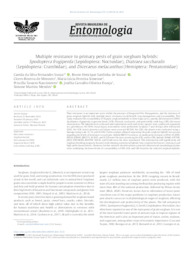Multiple resistance to primary pests of grain sorghum hybrids: Spodoptera frugiperda (Lepidoptera: Noctuidae), Diatraea saccharalis (Lepidoptera: Crambidae), and Diceraeus melacanthus (Hemiptera: Pentatomidae).
Multiple resistance to primary pests of grain sorghum hybrids: Spodoptera frugiperda (Lepidoptera: Noctuidae), Diatraea saccharalis (Lepidoptera: Crambidae), and Diceraeus melacanthus (Hemiptera: Pentatomidae).
Author(s): SOUZA, C. da S. F.; SOUZA, B. H. S. de; MENEZES, C. B. de; SIMEONE, M. L. F.; NASCIMENTO, P. T.; FRANÇA, J. C. O.; MENDES, S. M.
Summary: Plant resistance is an important tactic within the precepts of Integrated Pest Management, and the existence of grain sorghum hybrids with multiple insect resistance could benefit crop management and sustainability. This study evaluated the susceptibility of 30 grain-sorghum hybrids to three major pests, namely, fall armyworm (FAW) Spodoptera frugiperda, sugarcane borer (SCB) Diatraea saccharalis, and green-belly stink bug (GBS) Diceraeus melacanthus. The hybrids were cultivated and experiments with each insect species were conducted separately in a greenhouse. For FAW, visual injury assessments were performed on plants 7 and 14 days after infestation (DAI). For SCB, insect presence and injury were assessed 40 DAI. For GBS, the plants were evaluated using a damage rating scale 12, 19, and 26 DAI. Cluster analysis allowed separating the grain sorghum hybrids into groups regarding the levels of resistance to each pest. Hybrid BRS373 stood out as moderately resistant to FAW; AG1090, 80G20, BRAVO, BRS373, AG1615, and IG220 were the most promising for SCB; and for GBS, hybrids 50A40, A9735R, JADE, ENFORCER, BUSTER, 50A10, and IG244 were the most nominated. This information will significantly aid sorghum breeding programs focused on developing commercial hybrids that comprise both insect-resistance and high-yield characteristics. However, further research should evaluate potential chemical and morphological plant traits underlying the lower levels of susceptibility to FAW, SCB, and GBS found in the selected sorghum hybrids.
Publication year: 2023
Types of publication: Journal article
Unit: Embrapa Maize & Sorghum
Keywords: Host plants, Sorgo, Sugarcane
Observation
Some of Embrapa's publications are published as ePub files. To read them, use or download one of the following free software options to your computer or mobile device. Android: Google Play Books; IOS: iBooks; Windows and Linux: Calibre.
Access other publications
Access the Agricultural Research Database (BDPA) to consult Embrapa's full library collection and records.
Visit Embrapa Bookstore to purchase books and other publications sold by Embrapa.

